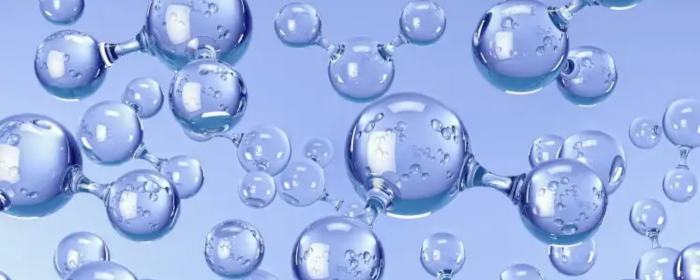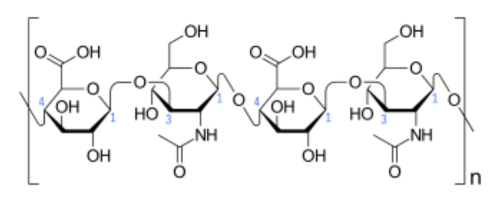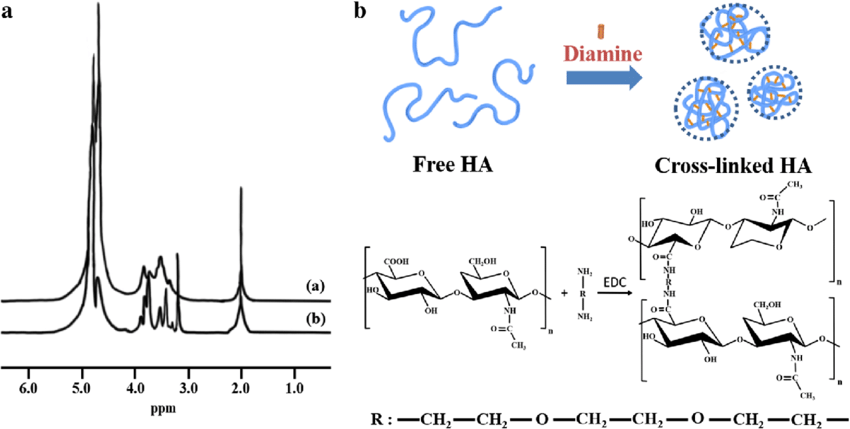
Hyaluronic acid
Hyaluronic acid, also known as sodium hyaluronate, is a linear high molecular weight polysaccharide using disaccharide as a repeating unit.
Hyaluronic acid can be roughly divided into large molecules, medium molecules, small molecules, and ultra-low molecules. They have different skin feel, viscosity, and efficacy, which can meet the needs of different application scenarios.

Hydrolyzed Hyaluronic Acid
The hydrolyzed hyaluronic acid, also called oligomeric hyaluronic acid, means that the very low polymerization degree of hyaluronic acid. It’s usually lower than 10,000 Da molecular weight, namely, the small molecule hyaluronic acid with monosaccharide structure less than 50 and the polymerization degree less than 25 degrees, for example, HA-Oligo. HA-Oligo is a native hyaluronic acid, cut by a safe and non-allergenic recombinant human hyaluronidase and then processed through a special processing technology to form an activated bio-mucopolysaccharide fragment.
Because of the small molecular weight of HA-Oligo, it can penetrate into pores and intercellular gaps deep inside the skin down to the dermis, thus exerting a base repair effect which cannot be achieved by conventional hyaluronic acid. In addition, HA-Oligo has physiological functions and acts by repairing damaged skin cells, enhancing nutrient absorption in the skin, eliminating superoxide free radicals, enhancing the content of water in skin bases, promoting improvement in skin resistance, enhancing skin elasticity, and delaying skin aging.
Because of the low molecular weight, even highly concentrated HA-Oligo products exhibit low viscosity. Hence, it can be combined with regular molecular weight hyaluronic acid in a formula for enhancing the overall moisturizing ability of cosmetics and improving skin feel.
Acetylated Sodium Hyaluronate
Acetylated Sodium Hyaluronate is obtained by the acetylation of sodium hyaluronate. Such are Hymagic™-AcHA hereinafter referred to as AcHA. AcHA is a highly effective skin softening factor that increases lipophilicity based on hydrophilicity, enhances the affinity and adsorption of HA to the skin, and increases hydration capacity.
- High “skin absorption“: The skin affinity of AcHA is good, and it can be firmly adsorbed on the skin even after washing, hence its long-lasting moisturizing effect or softening action on the skin.
- Double moisturizing power: AcHA can show double moisturizing ability. It can rapidly combine water within an ultra-short time and raise the water content of the skin to keep it moist for 12 hours.
- Repair of skin barrier: Not only can AcHA promote the proliferation of epidermal cells, but it can also repair injured epidermal cells, improve the barrier function of stratum corneum, enhance natural resistance to invasion of external factors, and reduce trans-epidermal water loss to improve unsmooth and dry conditions of the skin.
Cross-linking Polymer of Sodium Hyaluronate
Under natural conditions, HA will naturally be degraded rapidly within the body; on the contrary, dissociation of its structure will also result in a partial loss of some special physical and chemical properties and bioactivity, which seriously limits its clinical application. Some scholars therefore take the three most abundant functional groups of hydroxyl, carboxyl, and acetamide to modify HA with certain cross-linking agents and obtain its derivatives.
These derivatives of hyaluronic acid retain the original physical and chemical properties of hyaluronic acid with an increased molecular weight. Still, they depict low toxicity, good biocompatibility, and resistance to degradation by hyaluronidase due to which HA can stay in the body for a longer period and stably exert its unique physical and chemical properties.
Through crosslinking technology, HA is crosslinked into a crosslinked product and possesses a dense mesh structure. This cross-linking reaction allows the HA macromolecules to be highly aggregated and folded locally, binding more water molecules to achieve film-forming, hydrating, and protective effects on the skin surface.
It can be used as a free radical scavenger for reducing pain and blisters after sun exposure. It can be used in skin care cosmetics, hair products, and also as a delivery system for watersoluble or oil-soluble active substances. Hyaluronic acid, after cross-linking, increases not only the relative molecular mass but also the volume, thus forming a network structure; its morphology is changed from sol to gel. Its enhancement in structure and function is striking.

Silanization of Hyaluronic Acid
It has been indicated in various experiments that silicon mainly exists in ECM and is the component to constitutes the whole formation of glycosaminoglycans and their related protein complexes in connective tissue. Exogenous silanol, or soluble silicone, mimics the silicon naturally occurring in the body. Thus, it may help in rebuilding the connective tissues and promote the proliferation of fibroblasts along with the production of collagen. It is also effective in moisturizing the skin, can remove the sticky feeling on the skin surface, has strong stability under high temperatures, and can prevent and repair skin damage.
Hydroxypropyl Trimethylammonium Chloride Hyaluronic Acid
Hydroxypropyl Trimethylammonium chloride hyaluronic acid is a cationic hyaluronic acid, and it’s mainly used in hair products. In addition to its hyaluronic acid moisturizing properties, it also has good adsorption and affinity for skin and hair, is not easy to wash off, and can play a long-lasting and efficient moisturizing role. As a moisturizing factor in shampoo and conditioner, it has a good conditioning effect, enhances skin moisturizing efficiency, reduces irritation, and is compatible with cationic, nonionic, anionic, and amphoteric systems.
Stanford Chemical Company (SCC) is a premium supplier specializing in sodium hyaluronate powder. Our product range includes:
- Cosmetic Grade Hyaluronic Acid
- Food-Grade Hyaluronic Acid
- Injection Grade Hyaluronic Acid
- Medical Grade Hyaluronic Acid
- Zinc Hyaluronate
Our sodium hyaluronate powder is Ecocert certified and produced under strict ISO 9001 and GMP standards. All products are fermentation-based, non-animal origin, non-GMO, and carry no BSE/TSE risk.
Related article:
